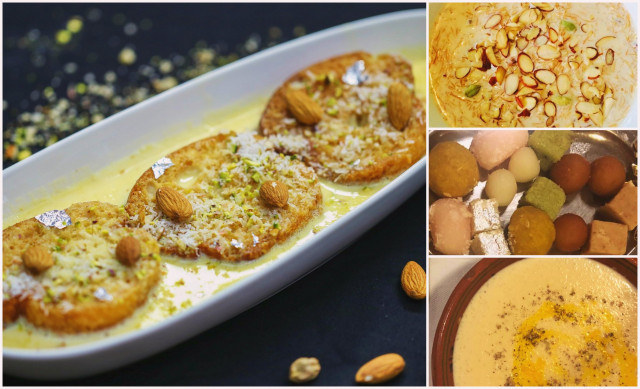The aroma of Eid: High on emotion and meetha, a new mum's festive rituals
'As I am writing this piece, I have soaked the rice for Kheer because my priorities in life are in order'

Ramazan may be about the pakoras, but Eid is definitely about dessert. As a 30-something millennial woman, I have realised that the cooking of dessert on Eid morning is almost a rite of passage, a sign of full-fledged adulting. Growing up, I would wake up to the fragrant aroma of freshly sprinkled cardamom over a hot bowl of sheer khurma prepared by my mother while my sister and I leisurely decked up for the day ahead.
It was the time of going to bed with dried mehndi (not washed) the night before, Patiala shalwars worn with a fitted shirt that had zips, pencil-thin eyebrows and over-the-top kohl in the eyes. Gen Z can gasp in horror.
My sister and I usually spent the first-day frying samosas, serving meetha and various batches of tea to the guests that poured in and out of our Karachi home through the three days of the holiday. As our fashion and eyebrows improved, Eid became a slightly less hectic affair. However, as siblings and cousins got married, changed cities or even countries, Eid has now become a much more intimate celebration.
This year, I am celebrating my first Eid as a new parent and as I am writing this piece, I have soaked the rice for Kheer because my priorities in life are in order. As I bought some chandi warq and took out my mother-in-law’s glazed terracotta platters to set the kheer in, I was reminded of all the Eids when I wasn’t so busy, the afternoon soirees at my grandmother’s North Karachi home every year. Or the Eid spent away from home as a graduate student when a Waitrose-bought-box kheer and Gulab Jamuns that cost 4 pounds each had to suffice.
Heavy on emotion and ingredients both, I have for you a few signature delicacies that almost have a ritualistic presence in our lives. No matter how well-decked you are and no matter how cool your partner’s kurta looks, it is these desserts that make Eid truly a celebration.
Sheer Khurma
Last year when Eid fell in the middle of May, I was halfway through a rough pregnancy. This meant that I was mostly nauseous and felt hotter than usual, a combination that made cooking during the daytime extremely difficult. However, on Eid morning, I got up to cook sheer khurma - the classic Eid dessert made with vermicelli, milk, and nuts (or dates) – at 40 degrees Celsius because I felt compelled to replicate in my own home, some ritual of the Eid festivities that I grew up with. Although I am calling what I make sheer khurma, I am not a big fan of raisins or dates in my dessert so well, a toned-down version if you like. On a previous Eid, I had also tried to make qawami sevayyan based on my phuppo’s recipe but unfortunately, this Lucknowi dish was not my cup of tea. I will get there, one day.
Home-made Kulfi
While I was growing up, Eid was a much grander affair than what it is today in my family. Every year on the second day of Eid, my nani threw a lunch for over 100 people! So, every year, the nicer outfit (if I made two that year) was saved for the second day. The highlight of this lunch was my nani’s batch of homemade kulfis. Set in small, conical-shaped steel containers, the kulfis were stored in an upright deep freezer in the dining room and were the quickest to go once served. Since we were the grandkids and somewhat higher on the hierarchy of relatives, nani often made and saved some extra ones for my cousins and me. While writing this piece, I reached out to my eldest cousin who is the keeper of all family recipes, and he told me that nani’s kulfi was made with only a few ingredients including milk, sugar, rose water and cardamom. He shared a similar recipe but assured me that no matter what we did, it would never turn out like Nani's.
Shahi Tukray
Literally meaning ‘royal bites’ or ‘royal pieces’, shahi tukray is essentially an extremely sweet and rich bread pudding. While its origins are mysterious, it may have likely been inspired by middle-eastern desserts and brought to South Asia by the early Mughal rulers. Royalty or not, I remember my mother often made it on Eid or as the showstopper after a big dinner. This one is truly nostalgic for I haven’t eaten it in a really long time and my family has also stopped making it. However, there is something so decadent about shahi tukray that it truly feels celebratory.
Kheer
My Nani also always served kheer set in beautiful terracotta dishes. Unlike the famous TV commercial where the daughter-in-law gets praise for making kheer out of a box mix (Is praise from the in-laws even a thing, and that too for box-made dessert?!?) my Nani’s kheer was cooked with love over several hours, the richness of its colour and texture evident of the labour that had gone into its preparation. She didn’t add saffron, which I liked because I have not been able to develop a taste for saffron despite getting an MA from SOAS. While I didn’t quite catch on to making the kulfi, I wrote down my Nani's kheer recipe in a notebook a few years ago and have used it since to recreate it every year on Eid. I am sharing it here:
Ingredients:
Milk
Rice (for 1 litre of milk, I will take 1 fistful of rice)
Sugar
Cardamom
Condensed milk (optional)
Method:
Rinse the rice thoroughly a few times before soaking it in water for at least 1-2 hours minimum and 3-4 hours if the quantity is more. In a large heavy pan, take 1 litre of full-fat milk and bring it to a boil cooking it at a low to medium flame, stirring the milk every now and then so that it does not burn at the bottom of the pan.
Once the milk comes to a boil, drain the water from the rice and add it to the milk stirring the rice slowly every few minutes. Let the milk and rice combination cook on a low to medium flame for at least 2-3 hours or until the rice has become softened and almost 80% cooked.
Add the sugar and condensed milk (sugar according to your taste, but I prefer dessert that is not extremely sweet) and continue to stir. Add crushed cardamom once the kheer is almost fully cooked. Pour the keer into a dish of your choice, I like to set it in a glazed terracotta bowl. Garnish with a mixture of crushed almonds, cardamom and chandi warq.
Have something to add to the story? Share it in the comments below.



















COMMENTS
Comments are moderated and generally will be posted if they are on-topic and not abusive.
For more information, please see our Comments FAQ